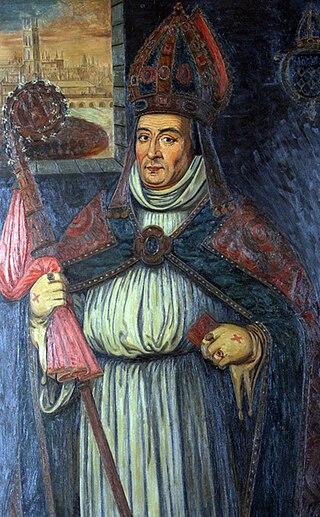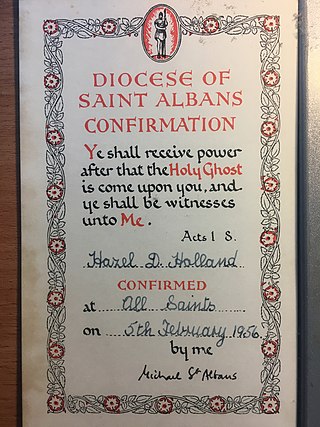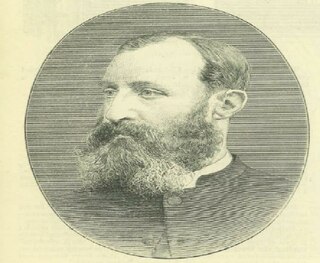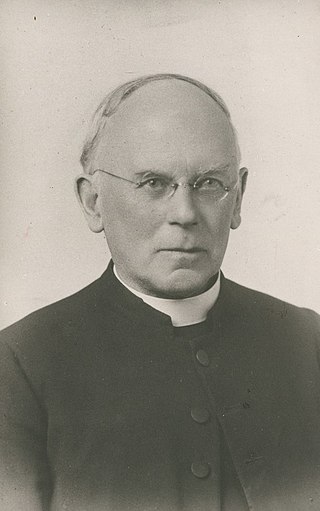
Germanus of Auxerre was a western Roman clergyman who was bishop of Autissiodorum in Late Antique Gaul. He abandoned a career as a high-ranking government official to devote his formidable energy towards the promotion of the church and the protection of his "flock" in dangerous times, personally confronting, for instance, the barbarian king "Goar". In Britain he is best remembered for his journey to combat Pelagianism in or around 429 AD, and the records of this visit provide valuable information on the state of post-Roman British society. He also played an important part in the establishment and promotion of the Cult of Saint Alban. The saint was said to have revealed the story of his martyrdom to Germanus in a dream or holy vision, and Germanus ordered this to be written down for public display. Germanus is venerated as a saint in both the Roman Catholic and Orthodox churches, which commemorate him on 31 July.

Richard John Carew Chartres, Baron Chartres,, FBS is a retired senior bishop of the Church of England.

William Waynflete, born William Patten, was Headmaster of Winchester College (1429–1441), Provost of Eton College (1442–1447), Bishop of Winchester (1447–1486) and Lord Chancellor of England (1456–1460). He founded Magdalen College, Oxford, and three subsidiary schools, namely Magdalen College School in Oxford, Magdalen College School, Brackley in Northamptonshire and Wainfleet All Saints in Lincolnshire.

The Bishop of St Albans is the Ordinary of the Church of England's Diocese of St Albans in the Province of Canterbury. The bishop is supported in his work by two suffragan bishops, the Bishop of Hertford and the Bishop of Bedford, and three archdeacons.

Edward Michael Gresford Jones was a Church of England bishop. He was the son of Herbert Gresford Jones who was also a bishop.
Robert Maynard Hardy was an Anglican bishop in the Church of England.

Richard Ian Cheetham is a retired Church of England bishop and former teacher. He served as the area Bishop of Kingston in the Diocese of Southwark, 2002–2022.
Simon Hedley Burrows was the Bishop of Buckingham from 1974 to 1994 and the first area bishop under the diocesan area scheme of 1984.

Henry Frank Johnson was a bishop in the Church of England from 1895.
Henry Aylmer Skelton was a bishop in the mid part of the twentieth century.
The Rt Rev Claude Thomas Thelluson Wood was an eminent Bishop in the mid part of the twentieth century.
Eric Joseph Trapp was an Anglican bishop in the mid-20th century.

John Reginald Harmer was a long-serving Anglican bishop who served in two dioceses.
Harold Eustace Sexton was an eminent Anglican bishop in the mid-20th century.

The Most Reverend William Marlborough Carter, (1850–1941) was an Anglican bishop and archbishop in South Africa.
Ernest Eric Hawkey was the sixth Bishop of Carpentaria from 1968 to 1974.

Paul Bayes is an English Anglican retired bishop. He served as Bishop of Liverpool, 2014–2022, and as Bishop of Hertford in the Church of England Diocese of St Albans, 2010–2014.
(Francis) Norman Thicknesse was Archdeacon of Middlesex, from 1930 until 1933.

St Alban's Church, Holborn, is a Church of England parish church in Holborn, central London, for a time becoming one of two churches of its parish which retains the name and St Peter's Saffron Hill to serve the mixed-use zone, notable for jewel-setting and for law firms. It has been Grade II* listed since 1951. This land is commonly – other than mainly to state Holborn, meaning part of Holborn – called Hatton Garden. St Peter's church is defunct, rationalising the number of churches in line with population changes of the district.

St Alban and St Stephen's Church or Ss Alban and Stephen Church is a Roman Catholic parish church in St Albans, Hertfordshire, England. Although it was built from 1903 to 1905, it was the third attempt to build a permanent local Catholic church in St Albans. It was designed by John Kelly of Kelly & Birchall in the Italian style. It is located on Beaconsfield Road next to the St Albans City railway station in the city centre.
This page is based on this
Wikipedia article Text is available under the
CC BY-SA 4.0 license; additional terms may apply.
Images, videos and audio are available under their respective licenses.











